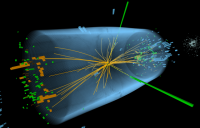
A new online course which offers people the chance to study the work of Nobel Prize-winning physicist Professor Peter Higgs is being offered.
The free seven-week course, entitled The Discovery of the Higgs boson, launched on Monday, 10 February and has already attracted more than 10,000 learners to register.
The course explores the scientific advancements that have led to the building of the Large Hadron Collider in Switzerland, and to the detection of the boson.
It features interviews with Prof. Higgs and filmed lectures by a team of world-class physicists from the School of Physics & Astronomy, led by Prof. Luigi del Debbio and Dr Christos Leonidopoulos and with support from 10 PhD students acting as teaching assistants. Students can debate what they have seen using dedicated online discussion spaces, as well as social media.
"We are extremely excited to be able to offer to a worldwide audience of online learners a unique insight into the work of Peter Higgs. This course, which describes how Peter's ideas have contributed to our current understanding of the physical phenomena at the smallest scales, is the first Massive Open Online Course (MOOC) to be offered by The University via the FutureLearn platform." Christos Leonidopoulos, Institute for Particle and Nuclear Physics
"We hope that this MOOC will help us share with people from all around the world, and from all walks of life, the excitement of the Higgs discovery, and some of the profound insights it gives us into the inner workings of the universe we live in." Richard Ball, Director of the Higgs Centre
"Professor Higgs’ research has provided us with profound insight into the building blocks of the Universe and this course will allow anyone with a computer and access to the web to take part in the exciting and revolutionary times that we live in." Prof. Arthur Trew, Head of School of Physics and Astronomy
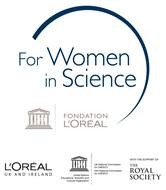
Applications for the L’Oréal-UNESCO UK and Ireland Fellowships For Women In Science open on 1 February 2014.
Four outstanding female post-doctoral scientists in the UK or Ireland will each be granted a fellowship worth £15,000 each, or the equivalent value in Euros for candidates in Ireland.
The Fellowships were launched in 2007 and provide flexible and practical help to female post-doctoral researchers. The winners may choose to spend their fellowship grants in any way that is helpful to them in furthering their research, from buying lab equipment, to hiring an assistant or paying for childcare costs.
The finalists will be selected by a panel of eminent scientists chaired by Prof. Pratibha Gai, including Prof. John Pethica FRS and Prof. Dame Janet Thornton FRS.
Deadline
The closing date for applications is Friday 14th March 2014.
Further information
For further information and to apply, see: www.womeninscience.co.uk
The programme is run in partnership with the UK National Commission for UNESCO and the Irish National Commission for UNESCO, with the support of the Royal Society.

The School of Physics & Astronomy seeks to appoint Chancellor's Fellows. These 5-year Fellowships are intended to support outstanding candidates at the start of their independent academic careers. The areas of strategic importance for this round are:
- Big Data
- Soft Condensed Matter
- Nuclear Physics
Who should apply?
We are looking for highly talented academics who will contribute to our continued achievement of excellence in research. Colleagues addressing data-intensive research are encouraged. You will already be working in an independent research capacity and will be developing your reputation for high quality research.
Chancellor’s Fellows also make an important contribution to enriching student learning experiences through their research, teaching and personal tutoring. You will concentrate on research initially, but will be trained in teaching skills and progressively take up this core academic activity.
We are particularly keen to encourage applications from candidates proposing interdisciplinary research.
How to apply
Applications containing a detailed CV and a 1-page outline of a proposed research programme indicating which strategic priority area you are interested in, should be made by applying to one or more of the available vacancies by 5pm GMT on 28th February 2014. Applications should be made via the University of Edinburgh's recruitment website.
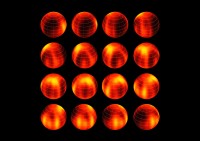
Researchers have mapped the surface of a brown dwarf – an object larger than a planet and smaller than a star – for the first time.
Scientists say the methods used in their study could eventually be applied to examine small, cool planets in other solar systems.
The team of European scientists carried out a pair of studies to analyse the atmosphere of the nearest brown dwarf to Earth, known as Luhman 16B, some 6.5 light years from the sun.
Researchers found that Luhman 16B has a complex structure of patchy clouds made up of droplets of liquid iron and other minerals, with temperatures in the clouds exceeding 1000°C.
Novel techniques
The brown dwarf is too far away for direct images of its surface to be captured, so the team applied a number of novel techniques using two telescopes in Chile to analyse its atmosphere. As Luhman 16B rotates, bright and dark clouds move in and out of view and its brightness changes.
In one study, led by the University of Edinburgh and published in Astrophysical Journal Letters, the team observed changes in the brown dwarf’s brightness and were able to reconstruct what happens in different layers of its atmosphere.
In a second study, led by the Max Planck Institute for Astronomy in Germany and published in Nature, the team used an indirect imaging technique to directly map out a layer of clouds.
“We are excited by what we have been able to see in these studies, but this is only the start. With new generations of telescopes, such as the forthcoming European Extremely Large Telescope, astronomers will likely see surface maps of more distant brown dwarfs – and eventually, surface maps for young giant planets.” Dr Beth Biller, now Institute for Astronomy, who led the second study.
Video
Zooming in on the nearby brown dwarf Luhman 16B
Flying among the closest stars to the Solar System
Image gallery

Interested in a new postgraduate opportunity in Astrobiology? We'd like to hear your views.
The School of Physics & Astronomy is considering launching a new postgraduate opportunity in Astrobiology.
We have set up a short survey and would be delighted to hear from anyone interested in postgraduate study in Astrobiology.
Your feedback could help shape the content and structure of this new programme, and there is an opportunity to leave your contact details so we can keep you up-to-date on any developments.
The survey
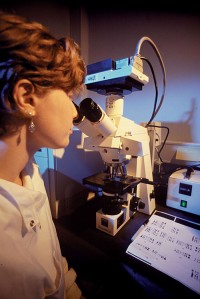
We are delighted to announce that the School of Physics & Astronomy has been recognised by the Institute of Physics (IOP) for its actions to address gender inequities across its student and staff body.
In awarding the prestigious Juno Champion status to the School, the IOP highlighted the clear and strong commitment of senior management to equality and diversity in the workplace, and particularly applauded the School’s progress in redressing historical gender imbalances in university physics.
“The Juno process gives us a wonderful opportunity to stand back and look at the changes we've made over the past 10 years, and celebrate the improvements that make the School a great place to work and study." Prof. Cait MacPhee, Institute for Condensed Matter and Complex Systems
"This award reflects the widespread desire within the School to ensure that in our pursuit of excellence we enable all to flourish. I am really pleased by the steps that we have taken and the commitment that everyone has shown to win us this prestigious award.” Prof. Arthur Trew, Head of School
To achieve the new status, we demonstrated progression against a range of Juno principles set up to improve the working culture. This is reflected in, for example, a high degree of overall satisfaction with the workplace, as expressed by staff members at all grades. Moreover, in contrast to national trends, there is no evidence for a “leaky pipeline” of women from the School as they progress from undergraduate through postgraduate to postdoctoral level. The award also celebrates the 5-fold increase in the proportion of female staff, and our increased levels of support for early career researchers, since we began the Juno journey in 2004.
The School of Physics & Astronomy joins a growing list of eight other physics departments named Juno Champions in the UK and Ireland, and is the second such award made to a Scottish Physics department.
The School’s Juno committee comprised Richard Blythe, Toni Collis, Ashley Cooke, Robyn Donnelly, Louise Ferguson, Cait MacPhee, Gill Maddy, Salomé Matos, John Peacock and Kate Slaughter.
Juno Code of Practice and level of engagement
The IOP's Code of Practice was developed in response to a recommendation of the International Perceptions of UK Research in Physics and Astronomy report that a special focus to attract and retain women in physics is needed.
The Code is based on best practice identified from IOP's "Women in University Physics departments: A Site Visit Scheme", which ran from 2003 to 2005. It sets out practical ideas for actions that departments can take to address the underrepresentation of women in university physics and emphasises the need for dialogue, transparency and openness.
There are three levels of engagement with the Code:
- As a Supporter, physics departments endorse the five principles set out in the Code of Practice.
- Practitioner status requires the department to demonstrate that its Juno journey is well underway and an initial evidence-based action plan demonstrating how the department aims to achieve Champion status is created.
- As a Champion, physics departments are confirmed to have met the five principles set out.
There are now 9 Champion departments, 13 Practitioners and 24 Supporters.
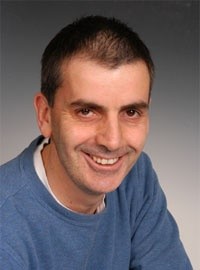
The Institute for Astronomy's Prof. James Dunlop has been awarded the 2014 George Darwin Lectureship by the Royal Astronomical Society. The Lecture is given annually, on a topic in astronomy, cosmology or astroparticle physics.
Prof. Dunlop is Head of the Institute for Astronomy, having previously held this position from 2002-2007. He has also received a Royal Society Wolfson Merit Award and currently holds an ERC Advanced Investigator Award.
"I am very honoured and pleased by this award of the George Darwin Lectureship from the RAS, especially given the impressive list of previous recipients. I would like to thank whoever nominated me, and also the awards committee of the RAS for providing me with such a positive start to 2014." Prof. James Dunlop
Award citation
Professor James Dunlop FRSE of the University of Edinburgh has played a leading role in transforming our understanding of how galaxies form. He has pioneered new fields of study and then established them as mature areas of research, often by leading major new observational programmes. The first systematic study of quasar host galaxies was carried out by Professor Dunlop, and he went on to discover that their basic properties are indistinguishable from their inactive counterparts.
He has demonstrated that the most massive radio galaxies and black holes formed before most of their lower mass counterparts, an effect known as 'downsizing'. Through his leadership on age-dating galaxies, he provided the first evidence that massive galaxies formed at redshifts greater than 5. He took sub-mm astronomy from its infancy, through developments in instrumentation with SCUBA, to establish the basic properties of star-forming galaxies shrouded in cosmic dust, and has played key roles in studying the formation of the very first galaxies.
For these reasons, Professor Dunlop is awarded the 2014 George Darwin Lectureship.

The School funds and supports six students with a bursary of £1,500 each to undertake projects within the School during the Summer vacation period.
Placements are open to students in the School of Physics & Astronomy and whose supervisor is a member of the School's staff. Projects should last a maximum of 8 weeks and will be defined and fully supported by members of academic staff.
Deadline for application
Fully completed applications should be submitted by the project supervisor, and must be received in the Physics & Astronomy Teaching Office no later than 5pm on Friday 14th February 2014.
Find out more
You can also read about some of our students' experiences on the summer placements webpage.
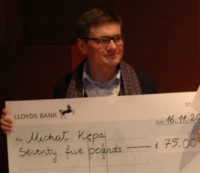
School PhD student Michal Kepa was awarded the 1st Audience Award and the 2nd Jury Award for his presentation at the Science. Polish Perspectives conference in Cambridge in November. Here is his report of the event.
Science. Polish Perspectives is a popular science conference addressed at young researchers of Polish origin working abroad, mainly in the UK but also in other countries. The aim of the conference is to popularise science and give an opportunity for young Polish researchers to communicate their research and participate in the discussion of Polish contributions to science.
The conference was held in English and gathered 170 guests and participants from 10 different countries. Several different workshops took place during the event, giving participants a chance to master science communication skills or to take part in technology-applied-to-business case studies.
This was the second Science. Polish Perspectives conference and, thanks to the organisers, it was a huge success and also a very enjoyable event. In my opinion, the best part of the conference was a chance to network and also get to know of opportunities for science communication and possible funding from different institutions, both Polish and international.
Presentation: Listening to Magnetism at Extreme Conditions
Abstract: Imagine that the samples in your laboratory could make sounds to tell you what properties they exhibit. Such an idea does not seem so strange if one applies ultrasound. Ultrasonic probe is mostly known for its application to investigate babies in the mothers’ wombs. However, it can be also used in condensed matter physics to study a variety of electrical and magnetic properties.
In my talk, I explained how ultrasound is used to listen to a sample when it becomes magnetic. I work on the uranium compound UGe2. When exposed to high pressures and very low temperatures, it becomes magnetic and also superconducting, which is a complete loss of electrical resistance. To carry out my project, I designed an apparatus which takes samples to pressures 25000 times greater than the atmospheric one. Magnetism and superconductivity are usually mutually exclusive. Understanding this exotic behaviour is a focus of my research.
Image gallery
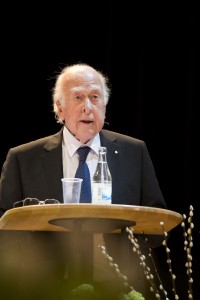
The distinguished scientist Professor Peter Higgs has been honoured by the Royal Swedish Academy for his work in predicting the Higgs boson particle.
Prof. Higgs came up with a theory for the particle, which is fundamental to the laws of physics, when he was a researcher at the University of Edinburgh in the 1960s. Its existence was confirmed almost 50 years later, in 2012, by the CERN research facility near Geneva. Prof. Higgs shares the 2013 Prize with Prof. Francois Englert of the Free University of Brussels, who independently researched the same theory.
Professor Higgs and other Nobel laureates will be presented with a medal and diploma by the King of Sweden at a formal ceremony at Stockholm Concert Hall. Presentations are followed by a banquet for laureates, their families and other guests at Stockholm City Hall.
“I am overwhelmed to receive this award and thank the Royal Swedish Academy. I would also like to congratulate all those who have contributed to the discovery of this new particle and to thank my family, friends and colleagues for their support.” Prof. Higgs
Building on the Higgs legacy
Higgs Centre for Innovation
The University of Edinburgh is building on the Higgs legacy by developing its expertise in physics. The University has welcomed the recent award of £10.7 million from the UK Treasury to create a Higgs Centre for Innovation. The Centre will be based at the Science and Technology Facilities Council’s (STFC) UK Astronomy Technology Centre (UK ATC), at the Royal Observatory Edinburgh.
Higgs Centre for Theoretical Physics
The University aims to create a new home for the Higgs Centre for Theoretical Physics at the University’s King’s Buildings campus. The Centre was created in 2012, following confirmation of the existence of the Higgs boson particle. Two new MSc programmes in Theoretical Physics and Mathematical Physics were also established as part of the Higgs Centre for Theoretical Physics.
Free online course
The University will soon begin delivering a free online course giving insight into the work of Professor Higgs. The seven-week course, the Discovery of the Higgs Boson, features interviews with the Professor and filmed lectures by other physicists at Edinburgh. The University is offering the Massive Open Online Course (MOOC) via the FutureLearn platform.
Prof. Higgs' Nobel Lecture
Profs Higgs and Englert presented lectures to an audience in Stockholm ahead of the Nobel ceremony. This video shows Prof. Englert's Nobel Lecture, The BEH Mechanism and its Scalar Boson, and Prof. Higgs' Nobel Lecture, Evading the Goldstone Theorem.

